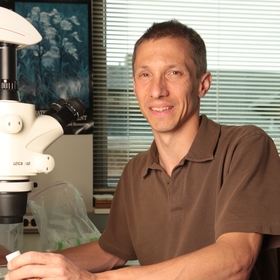

Jacques C.
Finlay
My lab explores the workings of freshwater ecosystems, and how watersheds, organisms and human activities alter their biogeochemistry, ecology and services. Current research projects includes work on urban landscapes, agricultural management and understanding the role of wetlands and wetland restorations in driving water quality changes.
Research statement
My lab does research on freshwater ecosystems at multiple scales and levels of organization. Current research focuses on urban and agricultural landscapes and understanding the ecology and role of small water bodies, such as ponds and wetlands, in watershed restoration and management. I am a co PI in a NSF funded long term ecological research site in the Twin Cities of Minnesota, leading research focused on the intersection between urbanization, climate and management determining water quality and ecology of urban freshwater systems. My work emphasizes integration of diverse datasets, models and interdisciplinary teams toward understanding and managing human driven change in ecosystems. A central focus of this work is identification of environmental thresholds in ecosystems, and understanding of broad, and often unanticipated consequences of land use, climate and management changes on ecosystem processes and water quality.
Selected publications
Winikoff, S. and J.C. Finlay. 2023. Temporal patterns in restored wetland water quality depend on hydroperiod rather than restoration strategy. Freshwater Science 42: 70-87 doi.org/10.1086/724014
Vossler, C. et al. 2023. Valuing Improvements in the Ecological Integrity of Local and Regional Waters using the biological condition gradient. PNAS 120: e2120251119 doi.org/10.1073/pnas.2120251119
Holgerson, M.A., D. Richardson, J. Roith, L.E. Bortolotti, K. Finlay, D. Hornbach, K. Gurung, A. Ness, M.R. Andersen, S. Bansal, J.C. Finlay, J.A. Cianci-Gaskill, S. Hahn, B.D. Janke, C. McDonald, J.P. Mesman, R.L. North, C.O. Roberts, J.N. Sweetman, and J.R. Webb. 2022. Classifying mixing regimes in ponds and shallow lakes. Water Resources Research.
Wu, Z., J. Li, Y. Sun, J. Peñuelas, J. Huang, J. Sardans, Q. Jiang, J.C. Finlay, G. L. Britten, M. J. Follows, W. Gao, B. Qin, J. Ni, S. Huo, and Y. Liu. 2022. Imbalance of global nutrient cycles exacerbated by the greater retention of phosphorus over nitrogen in lakes. Nature Geoscience 15:464-468. Editorial in Nature Geoscience.
Janke, B. D., J. C. Finlay, V. J. Taguchi, and J. S. Gulliver. 2022. Hydrologic processes regulate nutrient retention in stormwater detention ponds. Science of The Total Environment 823:153722.
Wollheim, W. M., T. K. Harms, A. L. Robison, L. E. Koenig, A. M. Helton, C. Song, W. B. Bowden, and J. C. Finlay. 2022. Superlinear scaling of riverine biogeochemical function with watershed size. Nature Communications 13:1230
Walter Anthony, K.M, S.A. Zimov, G. Grosse, M.C. Jones, P. Anthony, F. S. Chapin III, J.C. Finlay, M.C. Mack, S. Davydov, P. Frenzel, S. Frolking. 2014. A shift of thermokarst lakes from carbon sources to sinks during the Holocene epoch. Nature 511: 452-456 10.1038/nature13560
Tsui, M.T.K., J.D. Blum, J.C. Finlay, S.J. Balogh, Y.H. Nollet, W.J. Palen, and M.E. Power. 2014. Variation in terrestrial and aquatic sources of methylmercury in stream predators as revealed by stable mercury isotopes. Environmental Science & Technology. 48: 10128-10135 10.1021/es500517
Crawford, J.T., N.R. Lottig, E.H. Stanley, J,F. Walker, P.C. Hanson, J.C. Finlay, and R.G. Striegl. 2014. CO2 and CH4 emissions from streams in a lake-rich landscape: Patterns, controls and regional significance. Global Biogeochemical Cycles 28(3): 197-210 10.1002/2013GB004661.
Janke, B., J. C. Finlay, S. E. Hobbie, L. A. Baker, D. Nidzgorski, R.W. Sterner, and B. N. Wilson. 2014. Contrasting Influences of Stormflow and Baseflow Pathways on Nitrogen and Phosphorus Export from an Urban Watershed. Biogeochemistry 121(1): 209-228 10.1007/s10533-013-9926-1
Finlay, J.C., G.E. Small, and R.W. Sterner. 2013. Human influences on nitrogen removal in lakes. Science.342 (6155),247-250. DOI:10.1126/science.1242575.
Tsui M.T.K., J.D. Blum, J.C. Finlay, S.J. Balogh, S.Y. Kwon, and Y.H. Nollet. 2013. Photodegradation of Methylmercury in Stream Ecosystems. Limnology and Oceanography 58(1), 2013, 13–22 doi:10.4319/lo.2013.58.1.0013
Keeler, B.L., S. Polasky, K.A. Brauman, K.A. Johnson, J.C. Finlay, A. O’Neill, K. Kovacs, and B. Dalzell. 2012. Linking water quality and well-being for improved assessment and valuation of ecosystem services. Proceedings of the National Academy of Sciences 109(45): 18619-18624.
Baron, J.S., E.K. Hall, B.T. Nolan, J.C. Finlay, E. Bernhardt, J.A. Harrison, F. Chan, E.W. Boyer, 2012. The Interactive Effects of Human-Derived Nitrogen Loading and Climate Change on Aquatic Ecosystems of the United States. Biogeochemistry doi 10.1007/s10533-012-9788-y
Ishikawa, N.F., H. Doi, and J.C. Finlay. 2012. Global meta-analysis for controlling factors on carbon stable isotope ratio of lotic periphyton. Oecologia. DOI 10.1007/s00442-012-2308-x
Finlay, J.C. 2011. Stream size and human influences on ecosystem production in river networks. Ecosphere. 2(8): doi:10.1890/ES11-00071.1
Education and background
Education
Ph.D., University of California, Berkeley, 2000
Related links